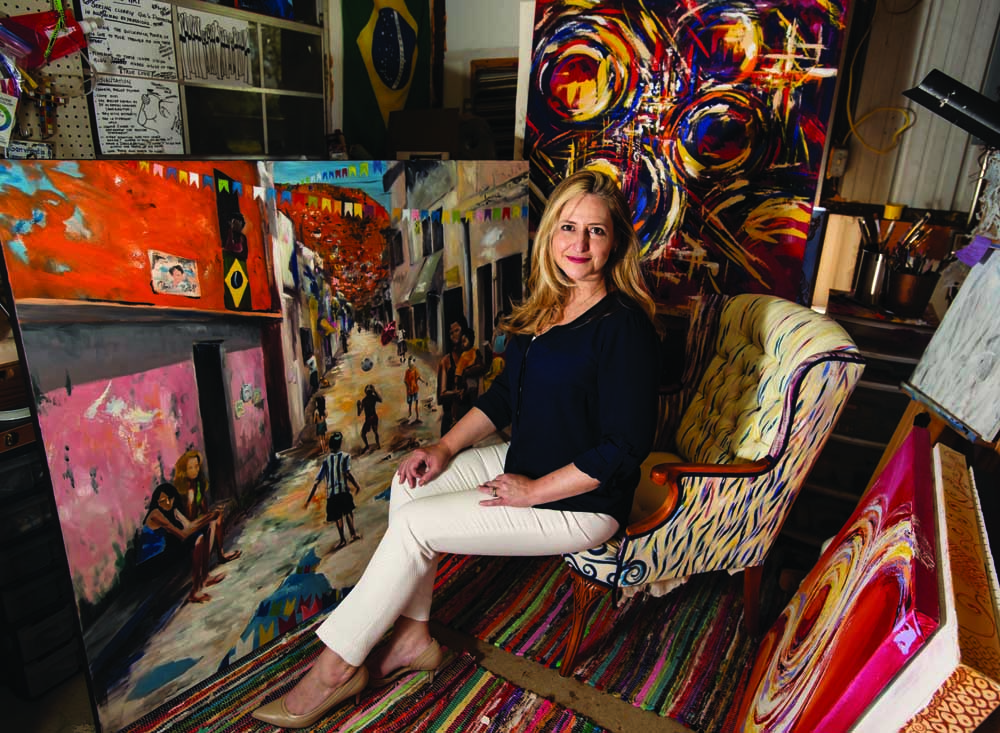Daniela Matchael uses bold colors and brushstrokes to tell stories
Published 8:00 am Wednesday, May 1, 2019

- Brazilian born artist Daniela Matchael works out of a small art studio at her home in Athens, Texas, pictured here on Tuesday March 27, 2019. Her paintings span different genres from abstracts to portraits of motherhood and shantytown scenes of Brazil's favelas. (Sarah A. Miller/Tyler Morning Telegraph)
Daniela Matchael is a storyteller but she doesn’t use words.
The Brazilian-born artist who lives in Athens tells stories through vibrant paintings that stylistically straddle a blurred line between expressionism and abstract.
Trending
She creates a painting in much the same way a writer crafts a story.
“As I create the art, shapes and images, characters of this artistic narrative, interact with each other as they build the plot of the work,” she shares on her website. “These interactions are built out of tension and … variations of color, texture and the placement of each element in the art pieces.”
The viewer is left to fill in the details.
“Unlike a written or verbal tale, visual art has endless possibilities,” she continues. “Once my work of creating and building the art is finished, the story belongs to the viewer of the artwork. Each person who interacts with the paintings, drawings, installations or any other art form I create, will tell their own story within the colors of the art.”
HERITAGE
In the living room of Matchael’s home, I am instantly attracted to a 40 x 40 abstract of what appears to be large swirling circles stuck in perpetual motion. The primary color is vivid red.
The bold color and sense of movement offer a window to her years of growing up in Brazil.
“You would go to the countryside and see these colors and at Carnival (an annual Brazilian celebration) you see these (colors) in the outfits. There’s always color. You cannot help but be influenced by that.”
Daniela was born in Campinas, Brazil. As a child she took lessons from artists in her home town. She later studied at the Panamerican School of Arts in Sao Paulo. For a few years, she taught art in Brazil. She later put her brushes away to pursue business opportunities.
After she moved to the United States in 1997, she took up art again. She married Michael Matchael and settled in Athens when he became the director of choral music at Trinity Valley Community College. They have two children.
In her home, Daniela draws my attention to another painting. At first it seems to depict nothing more than hundreds of tiny boxes stacked on one another.
She tells me that the boxes represent shacks packed together on a hillside shantytown — called a favela — in Rio De Janiero.
“These are dangerous places often controlled by drug lords,” she says, recalling how she made a trip back to Brazil a few years ago to work with nonprofit organizations that are trying to better the lives of the impoverished people who live in favelas.
“I told a cab driver that I wanted to go to the favela and he said, ‘No you don’t.'”
As part of an ongoing effort to raise awareness of the needs of people, especially children, in the favelas, Daniela painted the communities and their residents.
“These are forgotten people. Literally. Many of them don’t have birth certificates so when it comes to getting help from the government it’s like they don’t exist,” she says.
Daniela hopes her art will help outsiders see the favelas “in a way that they have never been seen before.”
Some of the money made through the sale of her favelas art is returned to the nonprofit agencies working to help the people.
ART
Daniela has traveled and shown her art throughout Europe, Brazil and the United States. Her art has received several awards including being named Best of Show at the “7 Artists, 7 Countries” exhibit at the Museum of the Americas in Doral, Florida.
Last year, the Valerosa Designs & Gallery in Tyler presented her work in a solo exhibition called “Movement in Retrospect.” The show included her favela paintings as well paintings from her Koi Series and Fields Collection.
Although the subject of her art varies, all of her work is characterized by distinct brushstrokes, the use of multiple oil and acrylic paints and impasto, the technique of applying paint quickly and thickly so that it stands out from the surface.
“As I build the layers of paint up on the canvas, from thinned down paint, to the thick impasto on the most prominent layers, I create a three-dimensional feel to the two-dimensional piece of art,” she adds on her website.
She says the technique allows her to “build paths, or valleys in between these mountains of paint. Sometimes these paths cut between elements in the paintings; others connect these elements. These corridors create the ability to generate what I call endless viewing outcomes to each of the paintings.”
The viewing outcome is different for everyone, she says.
“Each person who sees the painting can experience it … their own way. To each person, the painting becomes their own unique painting. It becomes a painting no one has probably ever seen that way before.”



